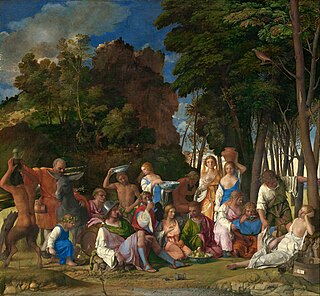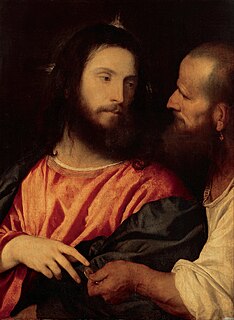
Dosso Dossi was an Italian Renaissance painter who belonged to the School of Ferrara, painting in a style mainly influenced by Venetian painting, in particular Giorgione and early Titian.

Benvenuto Tisi was a Late-Renaissance-Mannerist Italian painter of the School of Ferrara. Garofalo's career began attached to the court of the Duke d'Este. His early works have been described as "idyllic", but they often conform to the elaborate conceits favored by the artistically refined Ferrarese court. His nickname, Garofalo, may derive from his habit of signing some works with a picture of a carnation.
Carlo Bononi was an Italian painter.
The School of Ferrara was a group of painters which flourished in the Duchy of Ferrara during the Renaissance. Ferrara was ruled by the Este family, well known for its patronage of the arts. Patronage was extended with the ascent of Ercole d'Este I in 1470, and the family continued in power till Alfonso II, Ercole's great-grandson, died without an heir in 1597. The duchy was then occupied in succession by Papal and Austrian forces. The school evolved styles of painting that appeared to blend influences from Mantua, Venice, Lombardy, Bologna, and Florence.

Scarsellino or Ippolito Scarsella was an Italian mid-to-late sixteenth century reformist painter and one of the most important representatives of the School of Ferrara. His landscapes of both sacred and secular themes strongly anticipate the landscape painting traditions of the 17th century.
Sebastiano Filippi was an Italian late Renaissance – Mannerist painter of the School of Ferrara.

Ortolano was an Italian painter of the Ferrara School, active in the Renaissance period. Ticozzi cites his birth as ca. 1480.

Giuseppe Mazzuoli was an Italian painter of the Mannerist period, active mainly in the court of Alfonso II d'Este of Ferrara.

Francesco Costanzo Catanio, was a painter of the Italian Baroque period, born and mainly active in Ferrara. He was variously known as Catanio, Cattani, Cattaneo, or Cattanio, sometimes without the forename Francesco.

Giuseppe Bonati was an Italian painter of the Baroque period, active in Rome and Ferrara.
Giuseppe Avanzi was an Italian painter of the Baroque period, mainly active in Ferrara.
Ercole Sarti was an Italian painter of the Baroque period, active in Ferrara.

Giacomo Parolini was an Italian painter of the Baroque period, mainly active in Ferrara.
Giovanni Francesco Braccioli was an Italian painter of the Baroque period, mainly active in Ferrara.
Giuseppe Antonio Ghedini was an Italian painter of the Baroque period, mainly active in Ferrara.

The Feast of the Gods is an oil painting by the Italian Renaissance master Giovanni Bellini, with substantial additions in stages to the left and center landscape by Dosso Dossi and Titian. It is one of the few mythological pictures by the Venetian artist. Completed in 1514, it was his last major work. It is now in the National Gallery of Art in Washington D.C., which calls it "one of the greatest Renaissance paintings in the United States".

Gabriele Cappellini was an Italian painter of the Renaissance. He was also called il Caligarino or il Calzolaretto, from his having first pursued that trade. He was born in Ferrara, and there trained under Dosso Dossi, he was active c. 1520. For the church of San Francesco, Ferrara he painted a St. Peter and St. James and for San Giovannino the principal altar-piece, representing The Virgin and Infant with several Saints.
Events from the year 1542 in art.

The Tribute Money is a panel painting in oils of 1516 by the Italian late Renaissance artist Titian, now in the Gemäldegalerie Alte Meister in Dresden, Germany. It depicts Christ and a Pharisee at the moment in the Gospels when Christ is shown a coin and says "Render unto Caesar the things that are Caesar's, and unto God the things that are God's". It is signed "Ticianus F.[ecit]", painted on the trim of the left side of the Pharisee's collar.

The Pinacotecta Nazionale is an art gallery in Ferrara, Emilia-Romagna, Italy. It is located on the piano nobile of the Palazzo dei Diamanti, a work of Renaissance architecture by Biagio Rossetti, commissioned by Leonello d’Este in 1447. Not to be confused with the Civic Museum on the lower floor, which has hosted temporary exhibitions of contemporary art since 1992, the Pinacoteca houses a collection of paintings by the Ferrarese School dating from the thirteenth to the eighteenth centuries. It was founded in 1836 by the Municipality of Ferrara after Napoleon's widespread dissolution of churches threatened the protection of important public artworks. The gallery is formed as much around notable northern Italian painters as it is around the exquisite interior decoration of the palace itself, together with remnants of frescoes from local churches and later acquisitions from the Sacrati Strozzi collection.















